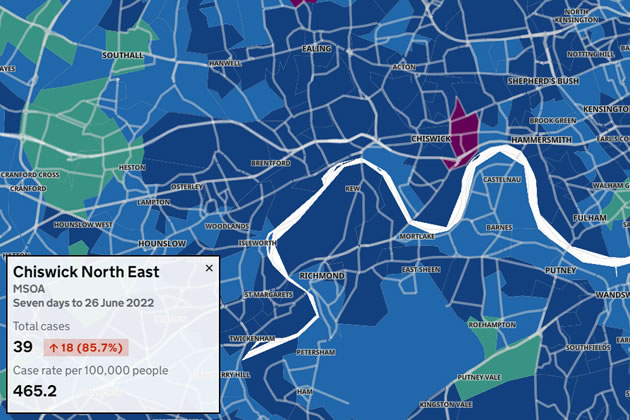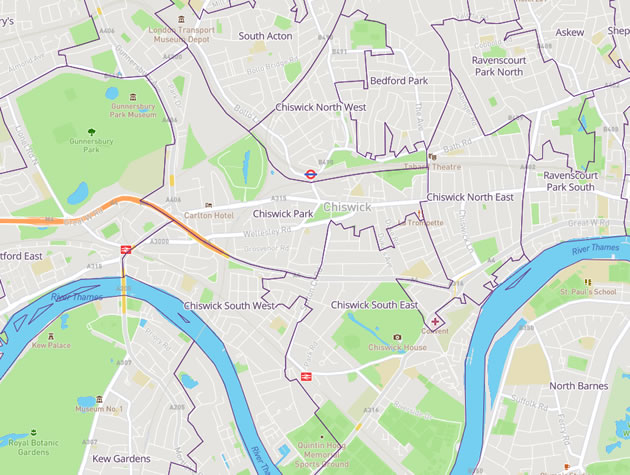Chiswick a Hot Spot for New Covid Surge
Parts of W4 have highest rate of infection in west London

Map of west London showing parts of Chiswick with highest infection rates. Source: ONS
The latest official data suggests that Chiswick is being particularly hard hit by the latest wave of Covid-19.
Government numbers indicate that 143 people in the W4 post code area became infected in the week to 26 June, the latest period for which numbers are available. However, health experts are cautioning that these statistics could significantly understate the prevalence of the virus.
The area designated as Chiswick North East (which covers much of Chiswick Homefields ward) saw the number of new cases rise by 87.5% to give an infection rate of 465.2 per 100,000 population equivalent as high as any area in west London.
Infections doubled in the Bedford Park area, although from a low base and the Chiswick South West area (which includes Strand on the Green and parts of Grove Park actually saw the number of cases decline during the same period.
Despite the high levels of the disease in Chiswick both Hounslow and Ealing boroughs currently have infection rates close to the London average at 191 and 194 respectively.
The latest surge of the disease is believed to be down to two new fast-spreading subvariants of Omicron dubbed as BA.4 and BA.5. These latest mutations of the virus are believed likely to become the dominant strains in the UK. They were added to the World Health Organization's monitoring list in March and have also been designated as variants of concern in Europe.
The new strains are not thought to be any more lethal than other types of Covid-19 and the population has built up a level of immunity due to previous infections and vaccinations. The fast spread of these new variants may be down to levels of immunity from earlier jabs and boosters waning and people are becoming infected even if they have had earlier versions of Omicron.
A local GP told us, "It would be wrong to overstate the importance of one set of figures for a small area as just a handful of extra cases can change the picture but Chiswick does seem to be a bit harder hit than other parts of London in the latest wave. My very speculative guess is that people who have been largely working from home during the pandemic have recently been going back to the office and picking up infections.
"Whatever the local factors, we know that these numbers significantly understate the true prevalence of the disease currently. With tests no longer free, fewer people are testing and many are not bothering to confirm that they have Covid when they become ill. With venues generally no longer requiring proof of virus-free status, another major incentive to get tested has gone.
"The advice as ever remains to get your jabs and boosters when they are available."
| Covid-19 Cases in Chiswick | |||
|---|---|---|---|
Area (MSOA) |
Cases |
Cases per 100,000 |
Change (%) |
Chiswick North East |
39 |
465.2 |
85.7 |
Chiswick Park |
31 |
348.0 |
34.8 |
Bedford Park |
19 |
275.1 |
111.1 |
Chiswick South East |
23 |
259.7 |
15.0 |
Chiswick North West |
16 |
234.8 |
77.8 |
Chiswick South West |
15 |
181.0 |
-25.0 |

Map showing the Middle Super Output Areas from the table above. Source: ONS
The number of people being admitted to hospital in London with Covid-19 has risen sharply in the last week. There were 1,638 patients as at 1 July compared to 1,301 the week before, however the number of people being treated on mechanical ventilators has fallen from 83 to 70.
In the week to 26 June, 16,878 new cases were identified in London, a rate of 188 cases per 100,000 population. This compares with 13,510 cases and a rate of 150 for the previous week. In England as a whole, there were 116,312 new cases, a rate of 206 cases per 100,000 population up from 154.
Up to and including 30 June 6,493,614 people in London had received the first dose of a COVID-19 vaccine and 6,077,034 had received two doses with 4,394,611 getting either a third vaccine dose or a booster dose.
Value Reading Articles Like This? Help Us Produce More This site remains committed to providing local community news and public interest journalism. Articles such as the one above are integral to what we do. We aim to feature as much as possible on local societies, charities based in the area, fundraising efforts by residents, community-based initiatives and even helping people find missing pets. We've always done that and won't be changing, in fact we'd like to do more. However, the readership that these stories generates is often below that needed to cover the cost of producing them. Our financial resources are limited and the local media environment is intensely competitive so there is a constraint on what we can do. We are therefore asking our readers to consider offering financial support to these efforts. Any money given will help support community and public interest news and the expansion of our coverage in this area. A suggested monthly payment is £8 but we would be grateful for any amount for instance if you think this site offers the equivalent value of a subscription to a daily printed newspaper you may wish to consider £20 per month. If neither of these amounts is suitable for you then contact info@neighbournet.com and we can set up an alternative. All payments are made through a secure web site. One-off donations are also appreciated. Choose The Amount You Wish To Contribute. If you do support us in this way we'd be interested to hear what kind of articles you would like to see more of on the site – send your suggestions to the editor. For businesses we offer the chance to be a corporate sponsor of community content on the site. For £30 plus VAT per month you will be the designated sponsor of at least one article a month with your logo appearing if supplied. If there is a specific community group or initiative you'd like to support we can make sure your sponsorship is featured on related content for a one off payment of £50 plus VAT. All payments are made through a secure web site. |
July 3, 2022